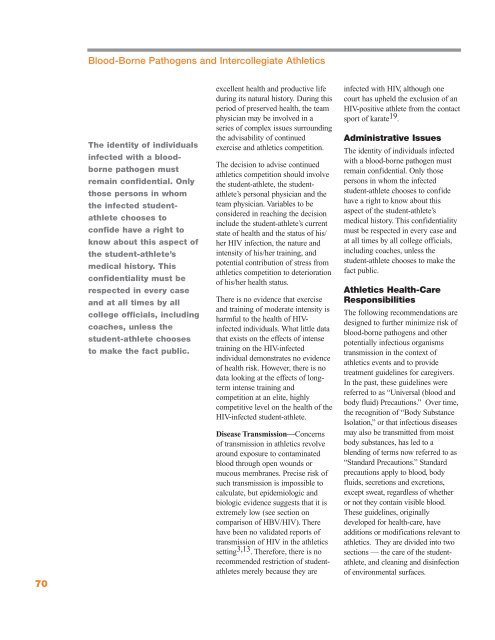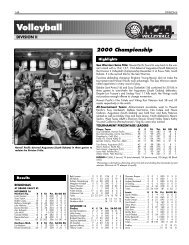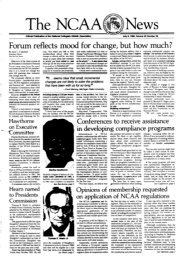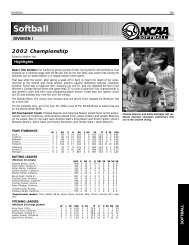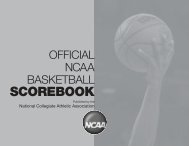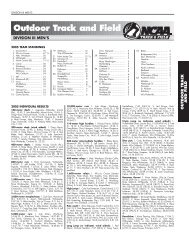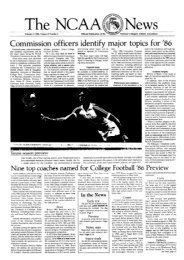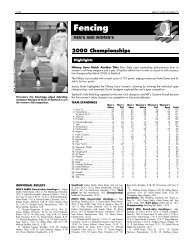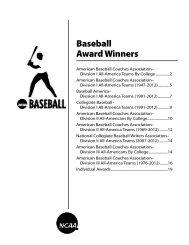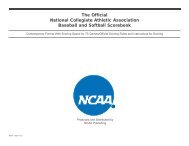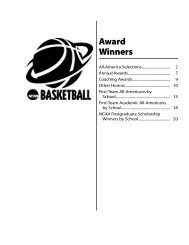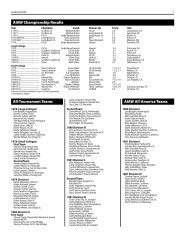Sports Medicine Handbook - NCAA
Sports Medicine Handbook - NCAA
Sports Medicine Handbook - NCAA
Create successful ePaper yourself
Turn your PDF publications into a flip-book with our unique Google optimized e-Paper software.
70<br />
Blood-Borne Pathogens and Intercollegiate Athletics<br />
The identity of individuals<br />
infected with a bloodborne<br />
pathogen must<br />
remain confidential. Only<br />
those persons in whom<br />
the infected studentathlete<br />
chooses to<br />
confide have a right to<br />
know about this aspect of<br />
the student-athlete’s<br />
medical history. This<br />
confidentiality must be<br />
respected in every case<br />
and at all times by all<br />
college officials, including<br />
coaches, unless the<br />
student-athlete chooses<br />
to make the fact public.<br />
excellent health and productive life<br />
during its natural history. During this<br />
period of preserved health, the team<br />
physician may be involved in a<br />
series of complex issues surrounding<br />
the advisability of continued<br />
exercise and athletics competition.<br />
The decision to advise continued<br />
athletics competition should involve<br />
the student-athlete, the studentathlete’s<br />
personal physician and the<br />
team physician. Variables to be<br />
considered in reaching the decision<br />
include the student-athlete’s current<br />
state of health and the status of his/<br />
her HIV infection, the nature and<br />
intensity of his/her training, and<br />
potential contribution of stress from<br />
athletics competition to deterioration<br />
of his/her health status.<br />
There is no evidence that exercise<br />
and training of moderate intensity is<br />
harmful to the health of HIVinfected<br />
individuals. What little data<br />
that exists on the effects of intense<br />
training on the HIV-infected<br />
individual demonstrates no evidence<br />
of health risk. However, there is no<br />
data looking at the effects of longterm<br />
intense training and<br />
competition at an elite, highly<br />
competitive level on the health of the<br />
HIV-infected student-athlete.<br />
Disease Transmission—Concerns<br />
of transmission in athletics revolve<br />
around exposure to contaminated<br />
blood through open wounds or<br />
mucous membranes. Precise risk of<br />
such transmission is impossible to<br />
calculate, but epidemiologic and<br />
biologic evidence suggests that it is<br />
extremely low (see section on<br />
comparison of HBV/HIV). There<br />
have been no validated reports of<br />
transmission of HIV in the athletics<br />
setting 3,13 . Therefore, there is no<br />
recommended restriction of studentathletes<br />
merely because they are<br />
infected with HIV, although one<br />
court has upheld the exclusion of an<br />
HIV-positive athlete from the contact<br />
sport of karate 19 .<br />
Administrative Issues<br />
The identity of individuals infected<br />
with a blood-borne pathogen must<br />
remain confidential. Only those<br />
persons in whom the infected<br />
student-athlete chooses to confide<br />
have a right to know about this<br />
aspect of the student-athlete’s<br />
medical history. This confidentiality<br />
must be respected in every case and<br />
at all times by all college officials,<br />
including coaches, unless the<br />
student-athlete chooses to make the<br />
fact public.<br />
Athletics Health-Care<br />
Responsibilities<br />
The following recommendations are<br />
designed to further minimize risk of<br />
blood-borne pathogens and other<br />
potentially infectious organisms<br />
transmission in the context of<br />
athletics events and to provide<br />
treatment guidelines for caregivers.<br />
In the past, these guidelines were<br />
referred to as “Universal (blood and<br />
body fluid) Precautions.” Over time,<br />
the recognition of “Body Substance<br />
Isolation,” or that infectious diseases<br />
may also be transmitted from moist<br />
body substances, has led to a<br />
blending of terms now referred to as<br />
“Standard Precautions.” Standard<br />
precautions apply to blood, body<br />
fluids, secretions and excretions,<br />
except sweat, regardless of whether<br />
or not they contain visible blood.<br />
These guidelines, originally<br />
developed for health-care, have<br />
additions or modifications relevant to<br />
athletics. They are divided into two<br />
sections — the care of the studentathlete,<br />
and cleaning and disinfection<br />
of environmental surfaces.


